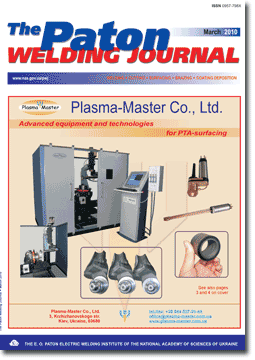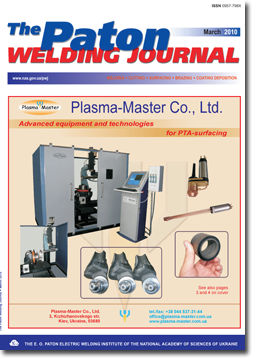
TPWJ, 2010, #3, 14-18 pages
STUDY OF RESIDUAL STRESS AND MECHANICAL PROPERTIES OF 2Cr13 STAINLESS STEEL STEAM TURBINE BLADES BY DIFFERENT LASER SURFACE MODIFICATIONS
Journal The Paton Welding Journal
Publisher International Association «Welding»
ISSN 0957-798X (print)
Issue № 3, 2010 (March)
Pages 14-18
Authors
JIANHUA YAO1, LIANG WANG1, QUNLI ZHANG1, ZHIJUN CHEN1 and V.S. KOVALENKO2
1Zhejiang University of Technology, Zhejiang, China
2Laser Technology Research Institute of the NTUU «Kiev Polytechnic Institute», Kiev, Ukraine
Abstract
As the key part of steam turbine, the blades work under the impact of high-speed steam and water droplet. Water droplet erosion on the inlet edge area is considered as the common failure pattern. In this paper, three laser surface modification ways including quenching, remelting and alloying were used to avoid water droplet erosion on the 2Cr13 stainless steel turbine blades. Residual stress and mechanical properties of the three modification methods were compared respectively. The result shows that the surface microhardness of blades increases after laser surface modifications. The tensile strength of the material is improved and meanwhile both the elongation percentage and reduction in cross sectional area are decreased. The impact fractures were all brittle fractures. The laser hardening zone presents residual compressive stress, and the heat-affected zone presents small transverse tensile stress.
Keywords: laser surface modification, turbine blade, residual stress, mechanical properties
Received: ??.??.??
Published: 28.03.10
References
1. Wei-Ze, W., Fu-Zhen, X., Kui-Long, Z. et al. (2006) Failure analysis of the final stage blade in steam turbine. Mater. Sci. Eng. A, 437, 70-74.
2. Mazur, Z., Garcia-Illescas, R., Aguirre-Romano, J. (2008) Steam turbine blade failure analysis. Eng. Fail. Anal., 15, 129-141.
3. Mann, B.S., Arya, V. (2003) HVOF coating and surface treatment for enhancing droplet erosion resistance of steam turbine blades. Wear, 254, 652-667.
4. Kathuria, Y.P. (2000) Some aspects of laser surface cladding in the turbine industry. Surf. Coat. Technol., 132, 262-269.
5. Bendeich, P., Alamb, N., Brandt, M. et al. (2006) Residual stress measurements in laser clad repaired low pressure turbine blades for the power industry. Mater. Sci. Eng. A, 437, 70-74.
6. de Camargo, J.A.M., Cornelis, H.J., Cioffi, V.M.O. et al. (2007) Coating residual stress effects on fatigue performance of 7050-T7451 aluminum alloy. Surf. Coat. Technol., 201, 9448-9455.
7. Borrego, L.P., Pires, J.T.B., Costa, J.M. et al. (2007) Fatigue behaviour of laser repairing welded joints. Eng. Fail. Anal., 14, 1586-1593.
8. Frenka, A., Marsdena, C.F., Wagnie'rea, J.-D. et al. (1991) Influence of an intermediate layer on the residual stress field in a laser clad. Surf. Coat. Technol., 45, 435-441.
AS = «Automatic Welding» - 6 issues per year;
TPWJ = «PATON WELDING JOURNAL» - 12 issues per year;
SEM = «Electrometallurgy Today» - 4 issues per year;
TDNK = «Technical Diagnostics and Non-Destructive Testing» - 4 issues per year.
| 2010 №03 (02) | 2010 №03 (04) |

TPWJ, 2010, #3, 14-18 pages
STUDY OF RESIDUAL STRESS AND MECHANICAL PROPERTIES OF 2Cr13 STAINLESS STEEL STEAM TURBINE BLADES BY DIFFERENT LASER SURFACE MODIFICATIONS
Journal The Paton Welding Journal
Publisher International Association «Welding»
ISSN 0957-798X (print)
Issue № 3, 2010 (March)
Pages 14-18
Authors
JIANHUA YAO1, LIANG WANG1, QUNLI ZHANG1, ZHIJUN CHEN1 and V.S. KOVALENKO2
1Zhejiang University of Technology, Zhejiang, China
2Laser Technology Research Institute of the NTUU «Kiev Polytechnic Institute», Kiev, Ukraine
Abstract
As the key part of steam turbine, the blades work under the impact of high-speed steam and water droplet. Water droplet erosion on the inlet edge area is considered as the common failure pattern. In this paper, three laser surface modification ways including quenching, remelting and alloying were used to avoid water droplet erosion on the 2Cr13 stainless steel turbine blades. Residual stress and mechanical properties of the three modification methods were compared respectively. The result shows that the surface microhardness of blades increases after laser surface modifications. The tensile strength of the material is improved and meanwhile both the elongation percentage and reduction in cross sectional area are decreased. The impact fractures were all brittle fractures. The laser hardening zone presents residual compressive stress, and the heat-affected zone presents small transverse tensile stress.
Keywords: laser surface modification, turbine blade, residual stress, mechanical properties
Received: ??.??.??
Published: 28.03.10
References
1. Wei-Ze, W., Fu-Zhen, X., Kui-Long, Z. et al. (2006) Failure analysis of the final stage blade in steam turbine. Mater. Sci. Eng. A, 437, 70-74.
2. Mazur, Z., Garcia-Illescas, R., Aguirre-Romano, J. (2008) Steam turbine blade failure analysis. Eng. Fail. Anal., 15, 129-141.
3. Mann, B.S., Arya, V. (2003) HVOF coating and surface treatment for enhancing droplet erosion resistance of steam turbine blades. Wear, 254, 652-667.
4. Kathuria, Y.P. (2000) Some aspects of laser surface cladding in the turbine industry. Surf. Coat. Technol., 132, 262-269.
5. Bendeich, P., Alamb, N., Brandt, M. et al. (2006) Residual stress measurements in laser clad repaired low pressure turbine blades for the power industry. Mater. Sci. Eng. A, 437, 70-74.
6. de Camargo, J.A.M., Cornelis, H.J., Cioffi, V.M.O. et al. (2007) Coating residual stress effects on fatigue performance of 7050-T7451 aluminum alloy. Surf. Coat. Technol., 201, 9448-9455.
7. Borrego, L.P., Pires, J.T.B., Costa, J.M. et al. (2007) Fatigue behaviour of laser repairing welded joints. Eng. Fail. Anal., 14, 1586-1593.
8. Frenka, A., Marsdena, C.F., Wagnie'rea, J.-D. et al. (1991) Influence of an intermediate layer on the residual stress field in a laser clad. Surf. Coat. Technol., 45, 435-441.
The cost of subscription/purchase order journals or individual articles
| Journal/Currency | Annual Set | 1 issue printed |
1 issue |
one article |
| AS/UAH | 1800 UAH | 300 UAH | 300 UAH | 150 UAH |
| AS/USD | 192 $ | 32 $ | 26 $ | 16 $ |
| AS/EUR | 180 € | 30 € | 25 € | 15 € |
| TPWJ/UAH | 7200 UAH | 600 UAH | 600 UAH | 280 UAH |
| TPWJ/USD | 384 $ | 32 $ | 26 $ | 16 $ |
| TPWJ/EUR | 360 € | 30 € | 25 € | 15 € |
| SEM/UAH | 1200 UAH | 300 UAH | 300 UAH | 150 UAH |
| SEM/USD | 128 $ | 32 $ | 26 $ | 16 $ |
| SEM/EUR | 120 € | 30 € | 25 € | 15 € |
| TDNK/UAH | 1200 UAH | 300 UAH | 300 UAH | 150 UAH |
| TDNK/USD | 128 $ | 32 $ | 26 $ | 16 $ |
| TDNK/EUR | 120 € | 30 € | 25 € | 15 € |
AS = «Automatic Welding» - 6 issues per year;
TPWJ = «PATON WELDING JOURNAL» - 12 issues per year;
SEM = «Electrometallurgy Today» - 4 issues per year;
TDNK = «Technical Diagnostics and Non-Destructive Testing» - 4 issues per year.

